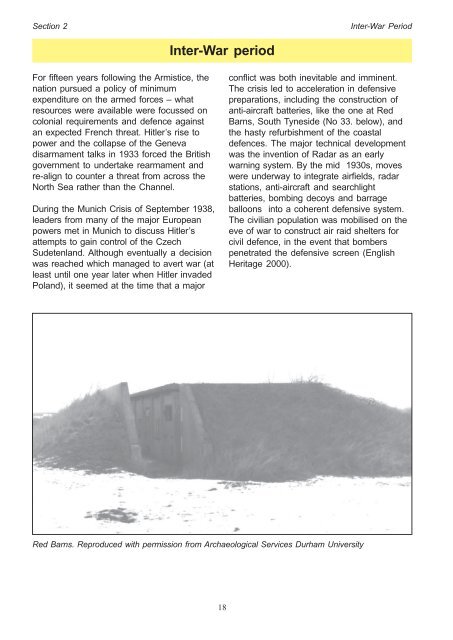TWENTIETH CENTURY DEFENCE SITES of TYNE and WEAR
TWENTIETH CENTURY DEFENCE SITES of TYNE and WEAR
TWENTIETH CENTURY DEFENCE SITES of TYNE and WEAR
Create successful ePaper yourself
Turn your PDF publications into a flip-book with our unique Google optimized e-Paper software.
Section 2 Inter-War Period<br />
For fifteen years following the Armistice, the<br />
nation pursued a policy <strong>of</strong> minimum<br />
expenditure on the armed forces – what<br />
resources were available were focussed on<br />
colonial requirements <strong>and</strong> defence against<br />
an expected French threat. Hitler’s rise to<br />
power <strong>and</strong> the collapse <strong>of</strong> the Geneva<br />
disarmament talks in 1933 forced the British<br />
government to undertake rearmament <strong>and</strong><br />
re-align to counter a threat from across the<br />
North Sea rather than the Channel.<br />
During the Munich Crisis <strong>of</strong> September 1938,<br />
leaders from many <strong>of</strong> the major European<br />
powers met in Munich to discuss Hitler’s<br />
attempts to gain control <strong>of</strong> the Czech<br />
Sudetenl<strong>and</strong>. Although eventually a decision<br />
was reached which managed to avert war (at<br />
least until one year later when Hitler invaded<br />
Pol<strong>and</strong>), it seemed at the time that a major<br />
Inter-War period<br />
Red Barns. Reproduced with permission from Archaeological Services Durham University<br />
18<br />
conflict was both inevitable <strong>and</strong> imminent.<br />
The crisis led to acceleration in defensive<br />
preparations, including the construction <strong>of</strong><br />
anti-aircraft batteries, like the one at Red<br />
Barns, South Tyneside (No 33. below), <strong>and</strong><br />
the hasty refurbishment <strong>of</strong> the coastal<br />
defences. The major technical development<br />
was the invention <strong>of</strong> Radar as an early<br />
warning system. By the mid 1930s, moves<br />
were underway to integrate airfields, radar<br />
stations, anti-aircraft <strong>and</strong> searchlight<br />
batteries, bombing decoys <strong>and</strong> barrage<br />
balloons into a coherent defensive system.<br />
The civilian population was mobilised on the<br />
eve <strong>of</strong> war to construct air raid shelters for<br />
civil defence, in the event that bombers<br />
penetrated the defensive screen (English<br />
Heritage 2000).

















